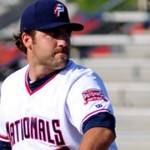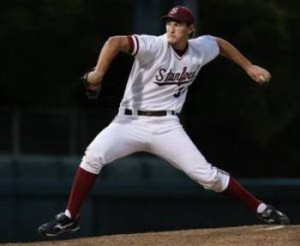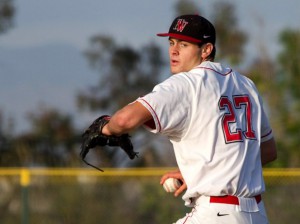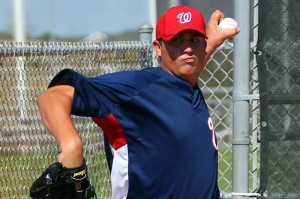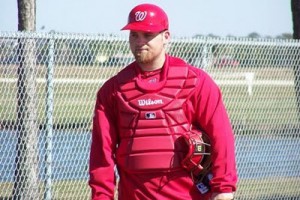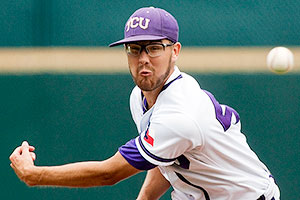The Rule 5 draft was conducted on 12/5/12, the last day of the Winter meetings, and the Nats farm system took a hit.
In the Major League Phase (full results from mlbtraderumors.com), we lost:
- Danny Rosenbaum, who was drafted 3rd overall by the Colorado Rockies.
- Jeff Kobernus, who was taken 7th overall by the Boston Red Sox, and immediately flipped to Detroit for a utility player.
Rosenbaum’s drafting isn’t a huge surprise, given his stature as the leading lefty starter prospect in our system and consistently being mentioned in top 10 lists and all-star teams. Rosenbaum’s problem is that he projects as a classic back-of-the-rotation lefty; decent but not eye-popping velocity, good control, keeping the ball in the park and giving you consistent innings, and the Nationals current management has little use for such a player. He projects almost exactly like John Lannan and Tommy Milone, two lefties that Rizzo didn’t covet and who were either flipped or non-tendered. Now, before bemoaning Rosenbaum’s loss too much, the odds of him being returned seem nearly 100%: Colorado is absolute hell on pitchers. He joins a team which lost 98 games and whose BEST starter last year posted a 4.43 ERA. Colorado is stock piling young starter prospects, running them through an unconventional pitch count limit system, and (I guess) seeing who stands out. Is Rosenbaum any better than the large handful of starters there already? I don’t think so; I suspect he’ll be back. Lets just hope he doesn’t return as damaged goods, as Brad Meyer was late last season.
Kobernus has to be excited; he goes from presumably being stuck in the minors for another year to getting a chance to make the 25-man roster team of the defending AL champs as a utility infielder. Our 2009 2nd round pick signed an under-slot deal (as did nearly everyone else in that draft thanks to the monies paid to Strasburg and Storen) and has posted decent if not flashy numbers in a steady progression through the system. In 2012 his slash line in AA was .282/.325/.333 and he was a mid-season all-star. I guess the team decided it just didn’t need a middle infielder who had little to no power (his best OPS season was in 2011 where he just reached .700). Can he stick in Detroit? I suspect he could, given the role he’s asked to perform. However, I worry that (much like Erik Komatsu in 2011, who it should be noted was NOT picked this year despite still being rule-5 eligible) he won’t be able to hit consistently enough to stay with the big team and may eventually be returned.
In the AAA phase, the team also lost:
- Jack McGeary, taken by Boston.
- Hector Nelo, taken by the Los Angeles Dodgers.
The departure of McGeary represents the end of a relatively tumultuous relationship between the one time upper-end prospect and team, and serves as a continuing cautionary tale of the risks behind drafting and paying high-end high school arms. McGeary wanted to attend Stanford and worked out a part-time playing deal to allow him to attend school. Admirable, but not exactly what a team expects for a $1.8M investment. After a couple of years he decided to finally focus on baseball first, but blew out his elbow in June 2010. His late 2011 return looked promising, but injuries cost him most of 2012 as well, pitching a grand total of 9 1/3 innings this year. After 6 full pro seasons he had yet to advance further than Low-A. Nats prospect fans have waited years and years for the likes of McGeary, Josh Smoker, Colton Willems and other top-5 talent High school arms to pan out, and have been left wanting. Arguably the best HS arm the team has drafted since relocating to Washington is Patrick McCoy, a lefty with halfway decent numbers in AA this past year and who has been passed over in two successive rule 5 drafts. At least the current regime seems to understand this; they’ve signed exactly three HS arms in the last three drafts combined and they’re all familiar names (Giolito, Cole, Ray).
Nelo ended the year as the AA closer, with pretty decent numbers, but himself was a 2011 minor league free agent and seemingly was considered nothing more than an organizational arm for the team. He was a right handed reliever in a system filled with such players , and his departure shouldn’t be missed too much.
In the end, the Rule 5 draft was as we expected it; it was rather anti-climactic for Nats fans who thought we may get a new player or two to try out. But as has been stated elsewhere, when the 25-man roster is nearly finalized for the 2013 season, there exists little need to experiment with a rule 5 draftee.

